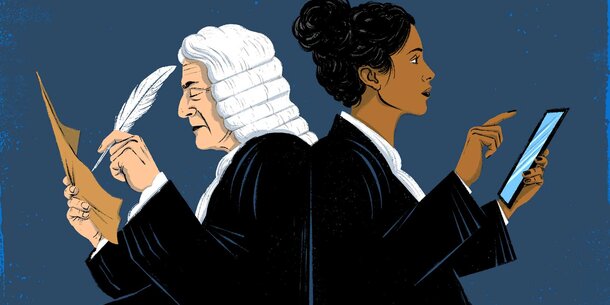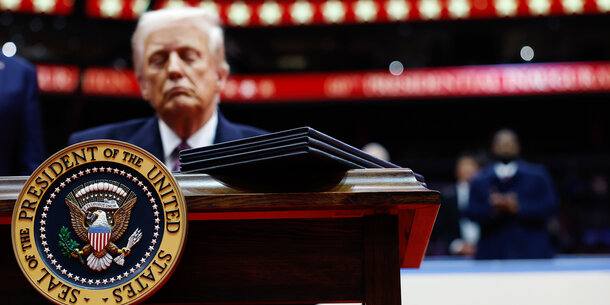The Supreme Court’s conservative supermajority might be set to knock another item off the right’s wish list. The court will hear two cases in January that could hobble federal agencies’ power to do their jobs by stopping them from using their discretion to interpret the law. Since agencies manage so much of American life — from the economy to food quality to nuclear power — the damage the court could do is dire. The rationale for doing it anyway, according to the corporations that brought these cases? A fictional version of American history.
The corporations mistakenly claim that, from the early years of the republic through the late 19th century, the federal courts were a strong check on federal agencies. They point to the framers’ concept of separated powers — according to which only courts can interpret the law — and the norms of 19th-century federal courts — according to which judges decided all legal questions raised by agencies’ actions for themselves. In reality, though, American agencies and courts didn’t work like that. The notion of the 19th-century federal judiciary micromanaging federal agencies is a historical fantasy meant to satisfy the conservative supermajority’s allegiance to originalism — that peculiar belief that judges should interpret the Constitution the way it was (supposedly) interpreted at the time it was drafted and ratified nearly two-and-a-half centuries ago.
Of course, if it were up to us, the Court wouldn’t be using history to make decisions about agencies’ powers or answer any other constitutional questions. But the gauntlet has been thrown, imaginary history is before the Court, and it can’t go unchallenged.
The founders created federal “departments” or agencies at the very dawn of the republic, and the courts had precious little to say to them until well after the Civil War. Left largely to themselves, these federal agencies were crucial to getting and keeping the young nation up and running. Discretion was key to their work.
For example, Alexander Hamilton’s Treasury Department collected the import taxes that helped the federal government finance its activities and pay its debts. The department’s customs officers had to decide when and how to enforce the law — or not — to keep traffic in the ports moving and ensure that merchants respected their authority. And customs officials — along with local physicians — also had wide latitude on questions critical to running a health care system for sailors. Early tax assessors and their supervisory boards had substantial say over how to value real estate and determine how much landowners owed the government. The military exercised its authority at will, wielding violence against Indians to expand the country from coast to coast. By the Civil War, federal agencies were making decisions on a massive scale about such activities as administering pensions, conducting safety inspections on steamboats, and resolving disputed land claims in the West.
It’s true that federal agencies in early America were smaller and their operations less extensive than the administrative state of today. But the early agencies still took charge of mission-critical matters. And while they were becoming an important part of American life, federal courts’ oversight of them was extremely limited — “anemic by modern standards,” as legal scholar Jerry Mashaw has put it. Back then, few people went to court to challenge federal agencies’ actions. And those that did were trying to get compensation or orders for officials to do their jobs, not trying to get courts to strike down agencies’ regulations.
It was only in the late 19th and early 20th century that the Supreme Court experimented with closely supervising agencies. By the middle of the 20th century, however, the Court had returned to something like first principles it drew from early case law. In 1984, the court created “Chevron deference,” which comes from the Supreme Court’s decision that year in Chevron v. Natural Resources Defense Council. More or less, it tells federal courts to defer to agencies’ reasonable interpretations of laws they’re in charge of implementing.
However, the corporations bringing the upcoming challenges to Chevron — Relentless v. Department of Commerce and Loper Bright Enterprises v. Raimondo — are hoping that the Court ignores the actual history of federal agencies in the early republic and beyond. They want the Court’s conservative supermajority to eliminate agency regulations — and maybe agencies themselves.
But the history just isn’t on their side. Chevron deference comes out of the country’s enduring tradition of federal agencies interpreting the law when they need to. The court shouldn’t use fake 19th-century history to strike it down.
For these cases, the history is clear: in the founding era and well beyond, federal courts rarely checked agencies’ activities. Claiming otherwise would mean either ignoring the record or abandoning its prized concept of “originalism.” Indeed, if the Court uses the story of the early judicial review to determine this decision, the justices wouldn’t be able to give the Chevron challengers what they want — removing the regulation they dislike from the books — because that’s not what the federal courts did in the 19th century.
The Court can’t find a warrant for undoing Chevron deference in a full account of American history. It isn’t consistent with the tradition of deference that stretches from the founding to the present day.
Gautham Rao is an associate professor of history at American University and the editor of Law & History Review. Rao is coauthor of an amicus brief submitted to the Supreme Court in Relentless v. Department of Commerce. Thomas Wolf is deputy director in the Brennan Center Democracy Program.




